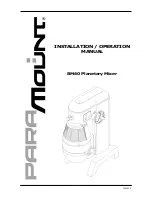
3.6
Solo Facility
3.6.1
This facility allows signal from any microphone channel to be fed to the left-
hand monitor loudspeaker in the control room without interfering in any way with any
recording which is in progress, the right hand loudspeaker being simultaneously
muted.
3.6.2
To allow the signal or noise on a channel to be heard when the fader is
closed, the tapping is taken from the input to the fader, and, in order to provide
isolation, is fed to the input of an Amplifier G. This amplifier, which is described in
12.8, has a voltage gain of unity and a low output impedance.
3.6.3
Each channel is provided with a push button located near the upper end of
the fader. Operation of this button connects the output of the Amplifier G through a
16k
Ω
resistor to the solo bus line and also operates the solo active relay in the
Control Room Monitor Cassette. This relay removes existing signals from the
loudspeakers and feeds signal from the bus line to the left-hand speaker.
3.7
Cue Channels
3.7.1 Cue Level Control
In order that a signal from a channel may be available for cueing purposes
when the fader is closed, the cue tapping must be taken from the input side of the
fader. This is the same point as is used for the solo facility so the output of the
Amplifier G is also fed to the cue level control, a logarithmic 5k
Ω
carbon
potentiometer.
3.7.2 Cue Line Selector
The slider of the cue level control potentiometer is connected to the cue
channel selector whereby the inputs of two Amplifiers B may neither, either or both
be connected thereto. In positions where an amplifier input is not connected to the
signal line, it is connected to the 0V line.
3.7.3 Cue Bus Lines
The outputs of the two Amplifiers B in each microphone channel are
connected to the Cue 1 and Cue 2 bus lines which are connected to the Cue Line
Output circuits in the Control Room Monitor Cassette.
3.8
Echo Circuits
3.8.1 Echo Level Control
The Echo Level Control is connected in parallel with the pan-pot. It is a
miniature stud switch potentiometer of about 6.8k
Ω
total resistance. It provides 20
steps of 2dB of attenuation and an “off” position. This control is used in several
places in the Mixer and is referred to as the general-purpose attenuator. In this
















































